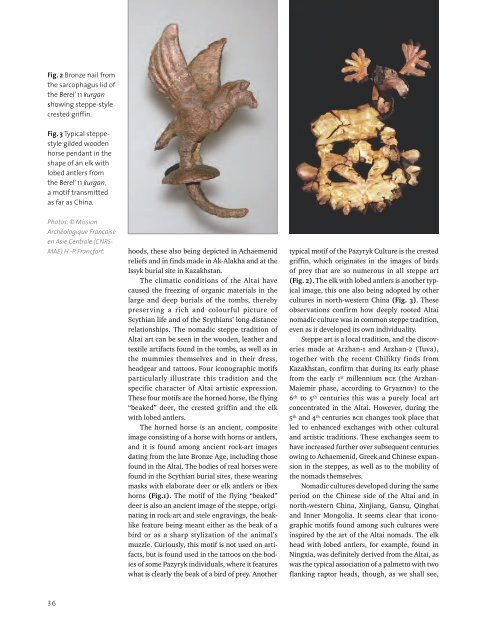Scythian Culture - Preservation of The Frozen Tombs of The Altai Mountains (UNESCO)
You also want an ePaper? Increase the reach of your titles
YUMPU automatically turns print PDFs into web optimized ePapers that Google loves.
Fig. 2 Bronze nail from<br />
the sarcophagus lid <strong>of</strong><br />
the Berel’ 11 kurgan<br />
showing steppe-style<br />
crested griffin.<br />
Fig. 3 Typical steppestyle<br />
gilded wooden<br />
horse pendant in the<br />
shape <strong>of</strong> an elk with<br />
lobed antlers from<br />
the Berel’ 11 kurgan,<br />
a motif transmitted<br />
as far as China.<br />
Photos: © Mission<br />
Archéologique Française<br />
en Asie Centrale (CNRS-<br />
MAE) H.-P. Francfort.<br />
hoods, these also being depicted in Achaemenid<br />
reliefs and in finds made in Ak-Alakha and at the<br />
Issyk burial site in Kazakhstan.<br />
<strong>The</strong> climatic conditions <strong>of</strong> the <strong>Altai</strong> have<br />
caused the freezing <strong>of</strong> organic materials in the<br />
large and deep burials <strong>of</strong> the tombs, thereby<br />
preserving a rich and colourful picture <strong>of</strong><br />
<strong>Scythian</strong> life and <strong>of</strong> the <strong>Scythian</strong>s’ long-distance<br />
relationships. <strong>The</strong> nomadic steppe tradition <strong>of</strong><br />
<strong>Altai</strong> art can be seen in the wooden, leather and<br />
textile artifacts found in the tombs, as well as in<br />
the mummies themselves and in their dress,<br />
headgear and tattoos. Four iconographic motifs<br />
particularly illustrate this tradition and the<br />
specific character <strong>of</strong> <strong>Altai</strong> artistic expression.<br />
<strong>The</strong>se four motifs are the horned horse, the flying<br />
“beaked” deer, the crested griffin and the elk<br />
with lobed antlers.<br />
<strong>The</strong> horned horse is an ancient, composite<br />
image consisting <strong>of</strong> a horse with horns or antlers,<br />
and it is found among ancient rock-art images<br />
dating from the late Bronze Age, including those<br />
found in the <strong>Altai</strong>. <strong>The</strong> bodies <strong>of</strong> real horses were<br />
found in the <strong>Scythian</strong> burial sites, these wearing<br />
masks with elaborate deer or elk antlers or ibex<br />
horns (Fig.1). <strong>The</strong> motif <strong>of</strong> the flying “beaked”<br />
deer is also an ancient image <strong>of</strong> the steppe, originating<br />
in rock-art and stele engravings, the beaklike<br />
feature being meant either as the beak <strong>of</strong> a<br />
bird or as a sharp stylization <strong>of</strong> the animal’s<br />
muzzle. Curiously, this motif is not used on artifacts,<br />
but is found used in the tattoos on the bodies<br />
<strong>of</strong> some Pazyryk individuals, where it features<br />
what is clearly the beak <strong>of</strong> a bird <strong>of</strong> prey. Another<br />
typical motif <strong>of</strong> the Pazyryk <strong>Culture</strong> is the crested<br />
griffin, which originates in the images <strong>of</strong> birds<br />
<strong>of</strong> prey that are so numerous in all steppe art<br />
(Fig. 2). <strong>The</strong> elk with lobed antlers is another typical<br />
image, this one also being adopted by other<br />
cultures in north-western China (Fig. 3). <strong>The</strong>se<br />
observations confirm how deeply rooted <strong>Altai</strong><br />
nomadic culture was in common steppe tradition,<br />
even as it developed its own individuality.<br />
Steppe art is a local tradition, and the discoveries<br />
made at Arzhan-1 and Arzhan-2 (Tuva),<br />
together with the recent Chilikty finds from<br />
Kazakhstan, confirm that during its early phase<br />
from the early 1 st millennium bce (the Arzhan-<br />
Maiemir phase, according to Gryaznov) to the<br />
6 th to 5 th centuries this was a purely local art<br />
concentrated in the <strong>Altai</strong>. However, during the<br />
5 th and 4 th centuries bce changes took place that<br />
led to enhanced exchanges with other cultural<br />
and artistic traditions. <strong>The</strong>se exchanges seem to<br />
have increased further over subsequent centuries<br />
owing to Achaemenid, Greek and Chinese expansion<br />
in the steppes, as well as to the mobility <strong>of</strong><br />
the nomads themselves.<br />
Nomadic cultures developed during the same<br />
period on the Chinese side <strong>of</strong> the <strong>Altai</strong> and in<br />
north-western China, Xinjiang, Gansu, Qinghai<br />
and Inner Mongolia. It seems clear that iconographic<br />
motifs found among such cultures were<br />
inspired by the art <strong>of</strong> the <strong>Altai</strong> nomads. <strong>The</strong> elk<br />
head with lobed antlers, for example, found in<br />
Ningxia, was definitely derived from the <strong>Altai</strong>, as<br />
was the typical association <strong>of</strong> a palmetto with two<br />
flanking raptor heads, though, as we shall see,<br />
36
















